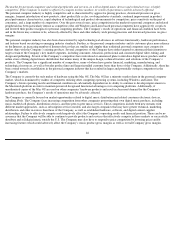Apple 2005 Annual Report Download - page 44
Download and view the complete annual report
Please find page 44 of the 2005 Apple annual report below. You can navigate through the pages in the report by either clicking on the pages listed below, or by using the keyword search tool below to find specific information within the annual report.
equity instruments. SFAS No. 123R eliminates the ability to account for share-based compensation transactions using the intrinsic value
method under Accounting Principles Board (APB) Opinion No. 25, Accounting for Stock Issued to Employees , and instead requires such
transactions be accounted for using a fair-value-based method. The Company will recognize stock-based compensation expense on all awards
on a straight-
line basis over the requisite service period using the modified prospective method. In January 2005, the SEC issued SAB No. 107,
which provides supplemental implementation guidance for SFAS No. 123R. SFAS No. 123R will be effective for the Company beginning in
the first quarter of fiscal 2006. The Company expects the adoption of SFAS No. 123R will result in a reduction of diluted earnings per common
share of approximately $0.03 for the first quarter of fiscal 2006.
In March 2005, the FASB issued Interpretation No. (FIN) 47, Accounting for Conditional Asset Retirement Obligations, to clarify the
requirement to record liabilities stemming from a legal obligation to perform an asset retirement activity in which the timing or method of
settlement is conditional on a future event. The Company plans to adopt FIN 47 in the first quarter of fiscal 2006, and does not expect the
application of FIN 47 to have a material impact on its results of operations, cash flows or financial position.
In May 2005, the FASB issued SFAS No. 154, Accounting Changes and Error Corrections which replaces APB Opinion No. 20 Accounting
Changes and SFAS No. 3, Reporting Accounting Changes in Interim Financial Statements—An Amendment of APB Opinion No. 28 .
SFAS No. 154 requires retrospective application to prior periods’ financial statements of a voluntary change in accounting principal unless it is
not practicable. SFAS No. 154 is effective for accounting changes and corrections of errors made in fiscal years beginning after December 15,
2005 and is required to be adopted by the Company in the first quarter of fiscal 2007. Although the Company will continue to evaluate the
application of SFAS No. 154, management does not currently believe adoption will have a material impact on the Company’s results of
operations or financial position.
Liquidity and Capital Resources
The following table presents selected financial information and statistics for each of the last three fiscal years (dollars in millions):
(a)
DSO is based on ending net trade receivables and most recent quarterly net sales for each period.
(b)
Days supply of inventory is based on ending inventory and most recent quarterly cost of sales for each period.
(c)
DPO is based on ending accounts payable and most recent quarterly cost of sales adjusted for the change in inventory.
As of September 24, 2005, the Company had $8.261 billion in cash, cash equivalents, and short-term investments, an increase of $2.797 billion
over the same balances at the end of 2004. The principal components of this increase were cash generated by operating activities of $2.535
billion and proceeds of $543 million from the issuance of common stock under stock plans, partially offset by cash used to
42
September 24,
September 25,
September 27,
2005
2004
2003
Cash, cash equivalents, and short-term investments
$
8,261
$
5,464
$
4,566
Accounts receivable, net
$
895
$
774
$
766
Inventory
$
165
$
101
$
56
Working capital
$
6,816
$
4,404
$
3,530
Days sales in accounts receivable (DSO) (a)
22
30
41
Days of supply in inventory (b)
6
5
4
Days payables outstanding (DPO) (c)
62
76
82
Annual operating cash flow
$
2,535
$
934
$
289
























